Page 74 of 416
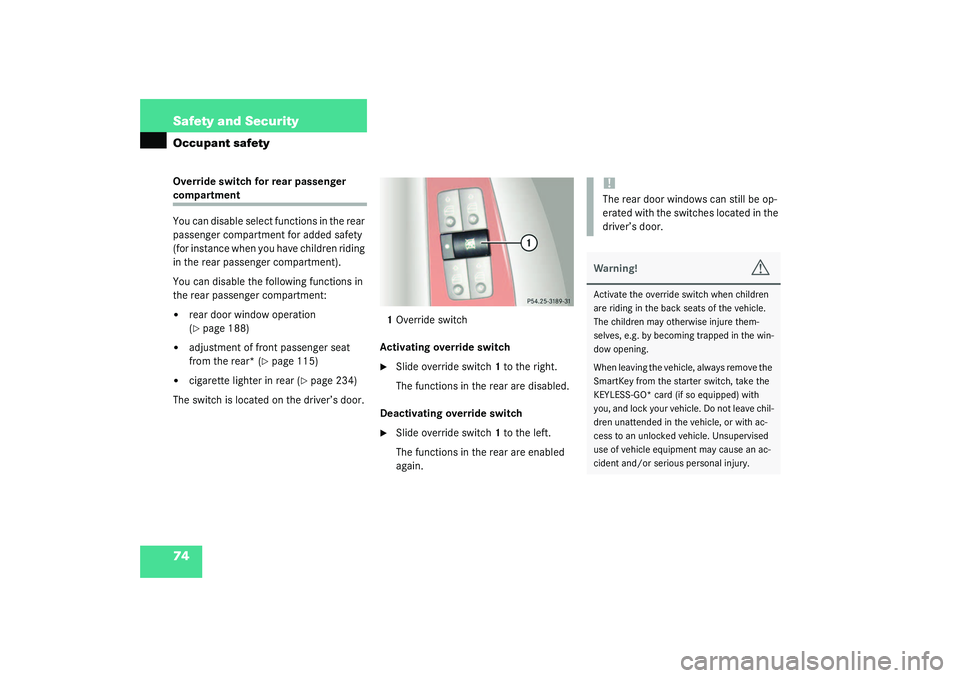
74 Safety and SecurityOccupant safetyOverride switch for rear passenger compartment
You can disable select functions in the rear
passenger compartment for added safety
(for instance when you have children riding
in the rear passenger compartment).
You can disable the following functions in
the rear passenger compartment:�
rear door window operation
(�page 188)
�
adjustment of front passenger seat
from the rear* (
�page 115)
�
cigarette lighter in rear (
�page 234)
The switch is located on the driver’s door.1Override switch
Activating override switch
�
Slide override switch 1 to the right.
The functions in the rear are disabled.
Deactivating override switch
�
Slide override switch 1 to the left.
The functions in the rear are enabled
again.
!The rear door windows can still be op-
erated with the switches located in the
driver’s door.Warning!
G
Activate the override switch when children
are riding in the back seats of the vehicle.
The children may otherwise injure them-
selves, e.g. by becoming trapped in the win-
dow opening.
When leaving the vehicle, always remove the
SmartKey from the starter switch, take the
KEYLESS-GO* card (if so equipped) with
you, and lock your vehicle. Do not leave chil-
dren unattended in the vehicle, or with ac-
cess to an unlocked vehicle. Unsupervised
use of vehicle equipment may cause an ac-
cident and/or serious personal injury.
Page 75 of 416
75 Safety and Security
Panic alarm
Panic alarm
An audible alarm and blinking exterior
lamps will operate for approximately
21/2minutes.
1Â
button
Activating�
Press and hold button1 for at least one
second.
Deactivating�
Press button1 again.
or
�
Insert SmartKey in starter switch.
iFor operation in the USA only: This de-
vice complies with Part 15 of the
FCC Rules. Operation is subject to the
following two conditions:
(1) This device may not cause harmful
interference, and
(2) this device must accept any inter-
ference received, including interfer-
ence that may cause undesired
operation.
Any unauthorized modification to this
device could void the user’s authority
to operate the equipment.
Page 77 of 416
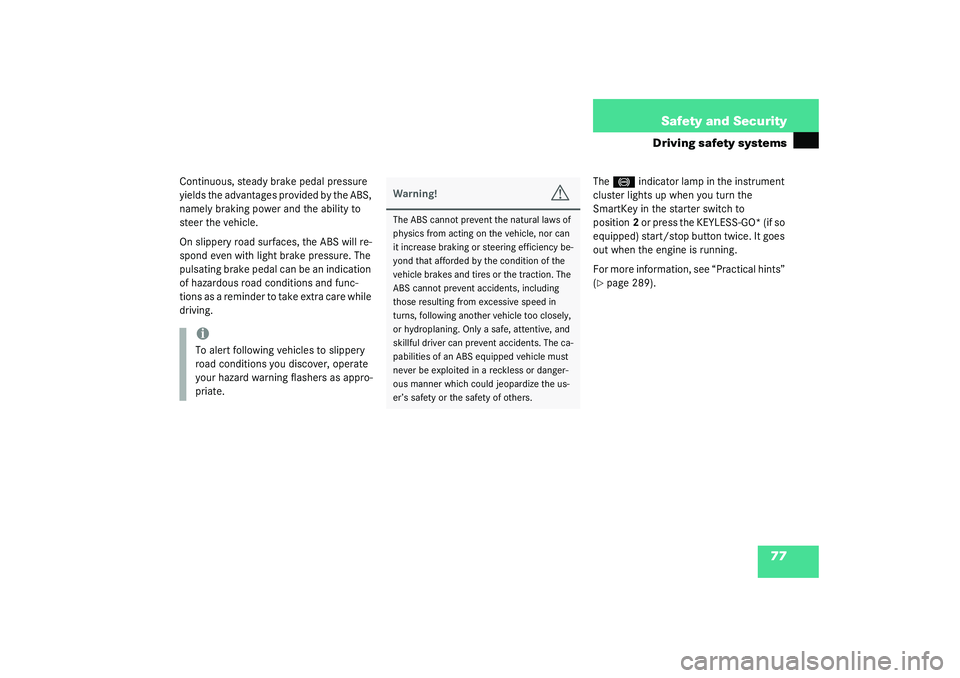
77 Safety and Security
Driving safety systems
Continuous, steady brake pedal pressure
yields the advantages provided by the ABS,
namely braking power and the ability to
steer the vehicle.
On slippery road surfaces, the ABS will re-
spond even with light brake pressure. The
pulsating brake pedal can be an indication
of hazardous road conditions and func-
tions as a reminder to take extra care while
driving.The
-
indicator lamp in the instrument
cluster lights up when you turn the
SmartKey in the starter switch to
position2 or press the KEYLESS-GO* (if so
equipped) start/stop button twice. It goes
out when the engine is running.
For more information, see “Practical hints”
(
�page 289).
iTo alert following vehicles to slippery
road conditions you discover, operate
your hazard warning flashers as appro-
priate.
Warning!
G
The ABS cannot prevent the natural laws of
physics from acting on the vehicle, nor can
it increase braking or steering efficiency be-
yond that afforded by the condition of the
vehicle brakes and tires or the traction. The
ABS cannot prevent accidents, including
those resulting from excessive speed in
turns, following another vehicle too closely,
or hydroplaning. Only a safe, attentive, and
skillful driver can prevent accidents. The ca-
pabilities of an ABS equipped vehicle must
never be exploited in a reckless or danger-
ous manner which could jeopardize the us-
er’s safety or the safety of others.
Page 78 of 416
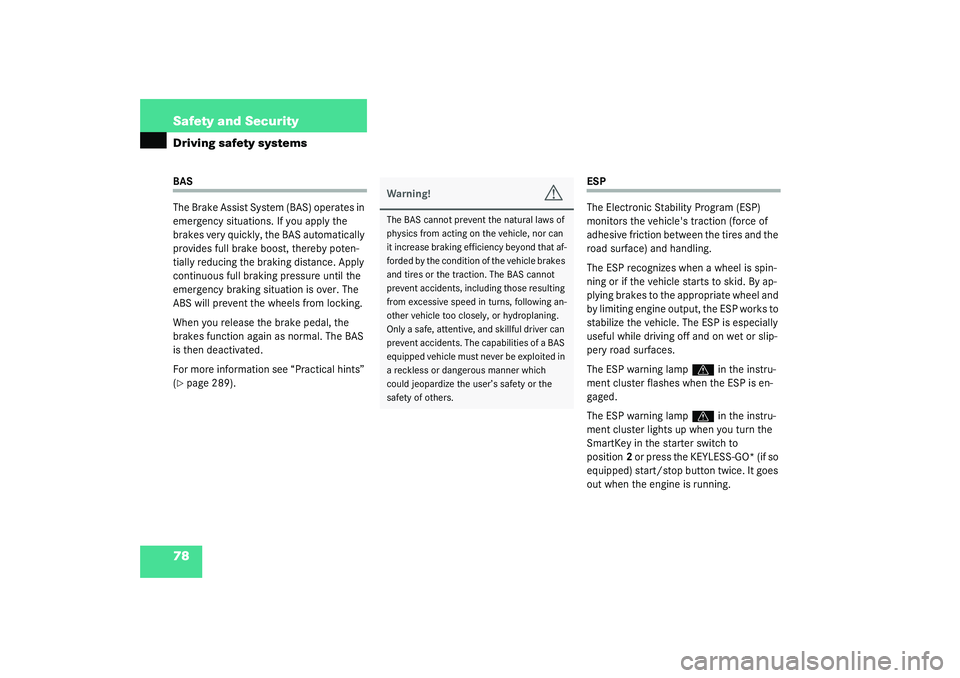
78 Safety and SecurityDriving safety systemsBAS
The Brake Assist System (BAS) operates in
emergency situations. If you apply the
brakes very quickly, the BAS automatically
provides full brake boost, thereby poten-
tially reducing the braking distance. Apply
continuous full braking pressure until the
emergency braking situation is over. The
ABS will prevent the wheels from locking.
When you release the brake pedal, the
brakes function again as normal. The BAS
is then deactivated.
For more information see “Practical hints”
(�page 289).
ESP
The Electronic Stability Program (ESP)
monitors the vehicle's traction (force of
adhesive friction between the tires and the
road surface) and handling.
The ESP recognizes when a wheel is spin-
ning or if the vehicle starts to skid. By ap-
plying brakes to the appropriate wheel and
by limiting engine output, the ESP works to
stabilize the vehicle. The ESP is especially
useful while driving off and on wet or slip-
pery road surfaces.
The ESP warning lamp
v
in the instru-
ment cluster flashes when the ESP is en-
gaged.
The ESP warning lamp
v
in the instru-
ment cluster lights up when you turn the
SmartKey in the starter switch to
position2 or press the KEYLESS-GO* (if so
equipped) start/stop button twice. It goes
out when the engine is running.
Warning!
G
The BAS cannot prevent the natural laws of
physics from acting on the vehicle, nor can
it increase braking efficiency beyond that af-
forded by the condition of the vehicle brakes
and tires or the traction. The BAS cannot
prevent accidents, including those resulting
from excessive speed in turns, following an-
other vehicle too closely, or hydroplaning.
Only a safe, attentive, and skillful driver can
prevent accidents. The capabilities of a BAS
equipped vehicle must never be exploited in
a reckless or dangerous manner which
could jeopardize the user’s safety or the
safety of others.
Page 79 of 416
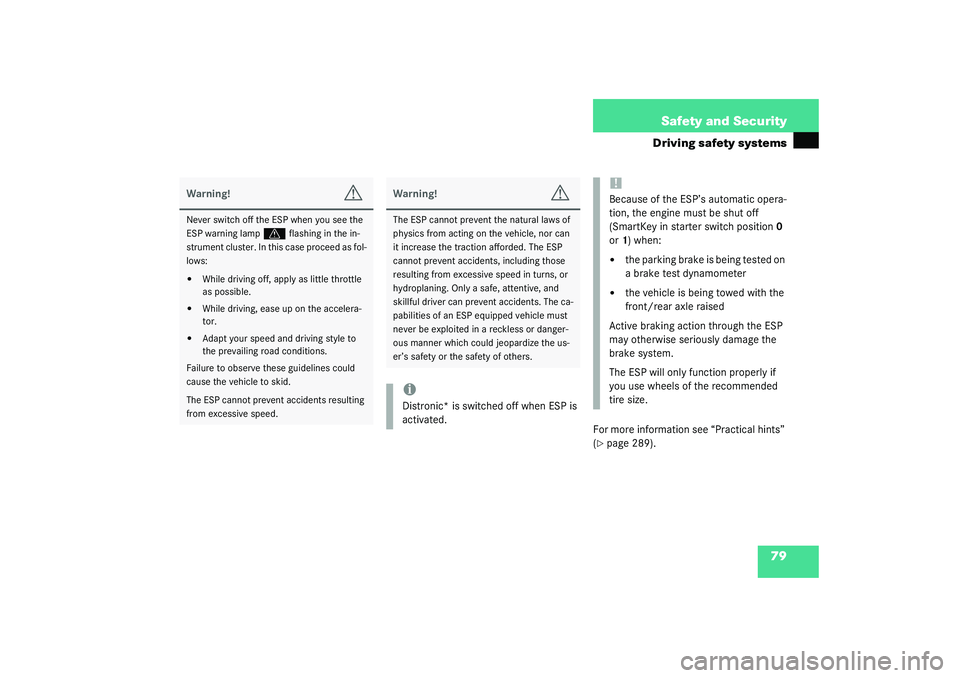
79 Safety and Security
Driving safety systems
For more information see “Practical hints”
(�page 289).
Warning!
G
Never switch off the ESP when you see the
ESP warning lamp
v
flashing in the in-
strument cluster. In this case proceed as fol-
lows:
�
While driving off, apply as little throttle
as possible.
�
While driving, ease up on the accelera-
tor.
�
Adapt your speed and driving style to
the prevailing road conditions.
Failure to observe these guidelines could
cause the vehicle to skid.
The ESP cannot prevent accidents resulting
from excessive speed.
Warning!
G
The ESP cannot prevent the natural laws of
physics from acting on the vehicle, nor can
it increase the traction afforded. The ESP
cannot prevent accidents, including those
resulting from excessive speed in turns, or
hydroplaning. Only a safe, attentive, and
skillful driver can prevent accidents. The ca-
pabilities of an ESP equipped vehicle must
never be exploited in a reckless or danger-
ous manner which could jeopardize the us-
er’s safety or the safety of others.iDistronic* is switched off when ESP is
activated.
!Because of the ESP’s automatic opera-
tion, the engine must be shut off
(SmartKey in starter switch position0
or1) when: �
the parking brake is being tested on
a brake test dynamometer
�
the vehicle is being towed with the
front/rear axle raised
Active braking action through the ESP
may otherwise seriously damage the
brake system.
The ESP will only function properly if
you use wheels of the recommended
tire size.
Page 81 of 416
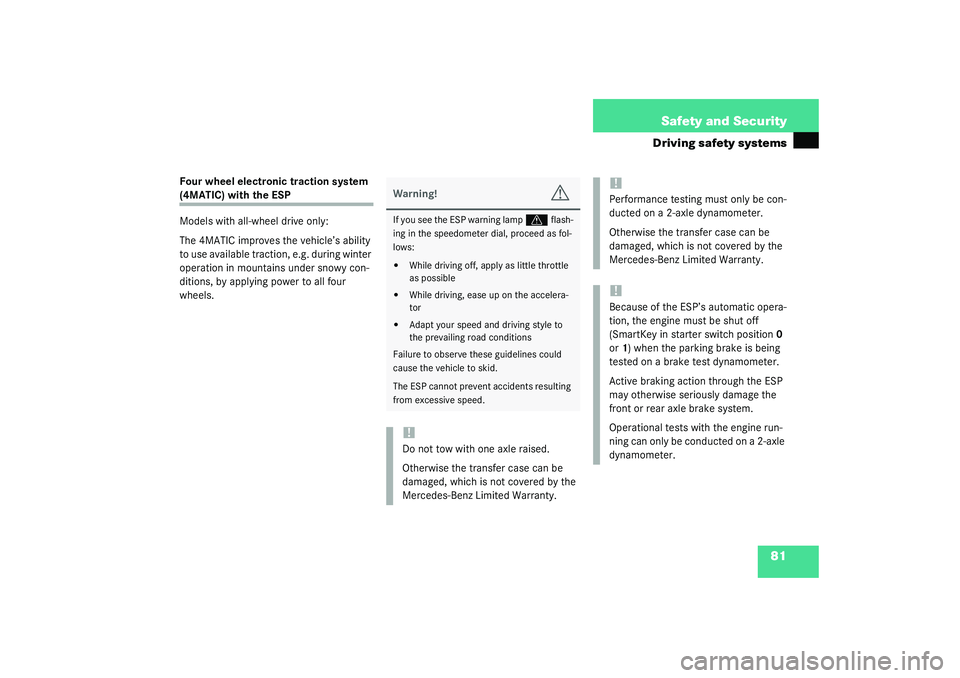
81 Safety and Security
Driving safety systems
Four wheel electronic traction system (4MATIC) with the ESP
Models with all-wheel drive only:
The 4MATIC improves the vehicle’s ability
to use available traction, e.g. during winter
operation in mountains under snowy con-
ditions, by applying power to all four
wheels.
Warning!
G
If you see the ESP warning lamp
v
flash-
ing in the speedometer dial, proceed as fol-
lows:
�
While driving off, apply as little throttle
as possible
�
While driving, ease up on the accelera-
tor
�
Adapt your speed and driving style to
the prevailing road conditions
Failure to observe these guidelines could
cause the vehicle to skid.
The ESP cannot prevent accidents resulting
from excessive speed.!Do not tow with one axle raised.
Otherwise the transfer case can be
damaged, which is not covered by the
Mercedes-Benz Limited Warranty.
!Performance testing must only be con-
ducted on a 2-axle dynamometer.
Otherwise the transfer case can be
damaged, which is not covered by the
Mercedes-Benz Limited Warranty.!Because of the ESP’s automatic opera-
tion, the engine must be shut off
(SmartKey in starter switch position0
or1) when the parking brake is being
tested on a brake test dynamometer.
Active braking action through the ESP
may otherwise seriously damage the
front or rear axle brake system.
Operational tests with the engine run-
ning can only be conducted on a 2-axle
dynamometer.
Page 82 of 416
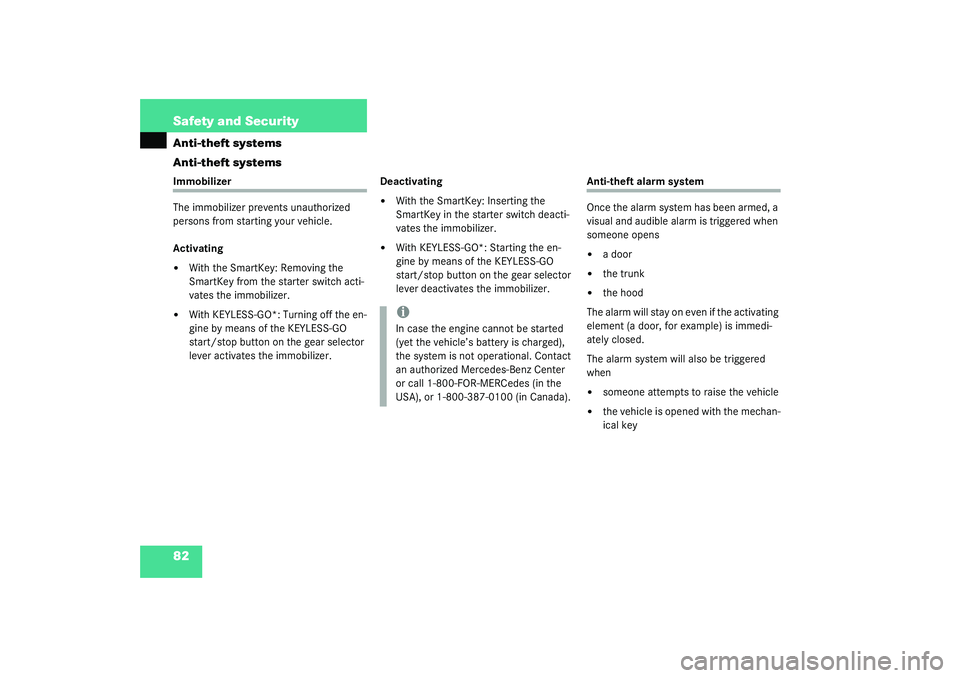
82 Safety and SecurityAnti-theft systems
Anti-theft systemsImmobilizer
The immobilizer prevents unauthorized
persons from starting your vehicle.
Activating�
With the SmartKey: Removing the
SmartKey from the starter switch acti-
vates the immobilizer.
�
With KEYLESS-GO*: Turning off the en-
gine by means of the KEYLESS-GO
start/stop button on the gear selector
lever activates the immobilizer.Deactivating
�
With the SmartKey: Inserting the
SmartKey in the starter switch deacti-
vates the immobilizer.
�
With KEYLESS-GO*: Starting the en-
gine by means of the KEYLESS-GO
start/stop button on the gear selector
lever deactivates the immobilizer.
Anti-theft alarm system
Once the alarm system has been armed, a
visual and audible alarm is triggered when
someone opens�
a door
�
the trunk
�
the hood
The alarm will stay on even if the activating
element (a door, for example) is immedi-
ately closed.
The alarm system will also be triggered
when
�
someone attempts to raise the vehicle
�
the vehicle is opened with the mechan-
ical key
iIn case the engine cannot be started
(yet the vehicle’s battery is charged),
the system is not operational. Contact
an authorized Mercedes-Benz Center
or call 1-800-FOR-MERCedes (in the
USA), or 1-800-387-0100 (in Canada).
Page 83 of 416
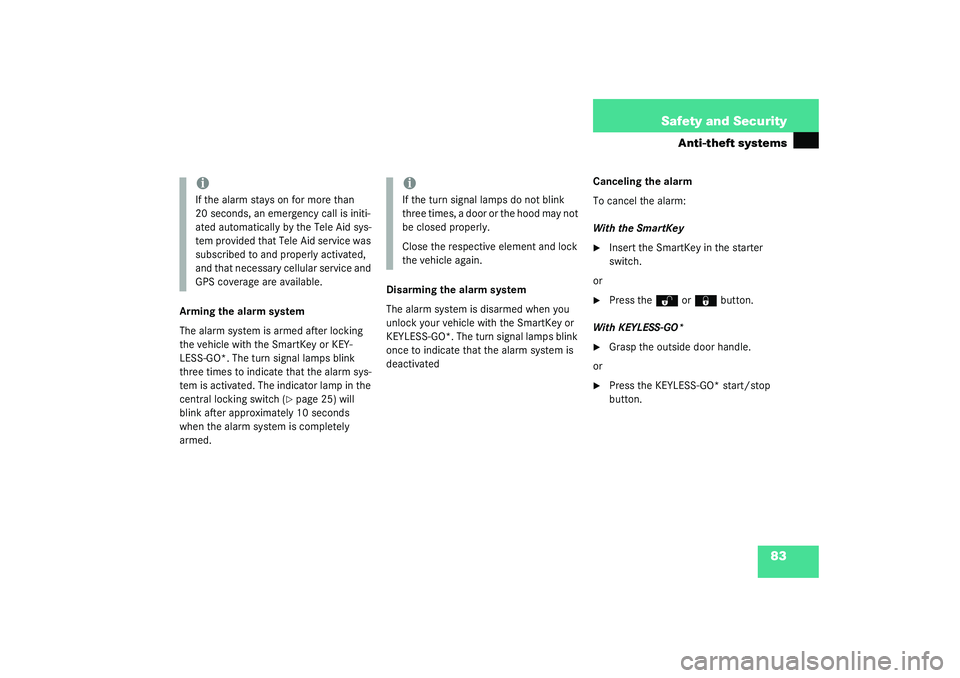
83 Safety and Security
Anti-theft systems
Arming the alarm system
The alarm system is armed after locking
the vehicle with the SmartKey or KEY-
LESS-GO*. The turn signal lamps blink
three times to indicate that the alarm sys-
tem is activated. The indicator lamp in the
central locking switch (
�page 25) will
blink after approximately 10 seconds
when the alarm system is completely
armed.Disarming the alarm system
The alarm system is disarmed when you
unlock your vehicle with the SmartKey or
KEYLESS-GO*. The turn signal lamps blink
once to indicate that the alarm system is
deactivatedCanceling the alarm
To cancel the alarm:
With the SmartKey
�
Insert the SmartKey in the starter
switch.
or
�
Press the
Œ
or
‹
button.
With KEYLESS-GO*
�
Grasp the outside door handle.
or
�
Press the KEYLESS-GO* start/stop
button.
iIf the alarm stays on for more than
20 seconds, an emergency call is initi-
ated automatically by the Tele Aid sys-
tem provided that Tele Aid service was
subscribed to and properly activated,
and that necessary cellular service and
GPS coverage are available.
iIf the turn signal lamps do not blink
three times, a door or the hood may not
be closed properly.
Close the respective element and lock
the vehicle again.